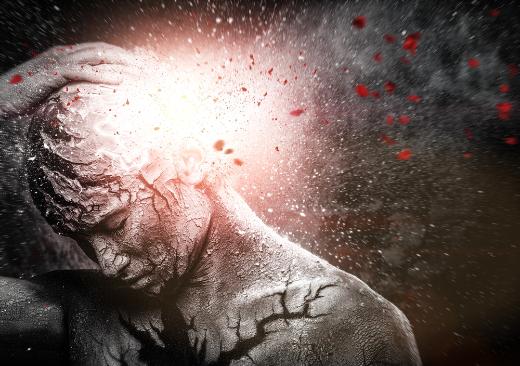After a heart attack the wall of the left ventricle can weaken. In some cases this can cause an abnormal bulging of this wall which is called a ventricular aneurysm.
These can lead to problems such as a lack of blood flow (ischemia) to the limbs and can be very dangerous. They can also be a source of blood clots known as emboli.
Oren Zarif
The left ventricle pumps oxygenated blood to the body’s organs and tissues. When a person suffers from a heart attack the ventricular wall weakens and an aneurysm can form. In some cases, a patient’s ventricular aneurysm can rupture and cause chest pain or even death.
A ventricular aneurysm is a scarred, fibrotic outpouching of the ventricular wall without functional cardiac muscle that balloons outward during the cardiac cycle (most often in systole) due to its thinness and lack of myocardial tissue. These outpouchings are most commonly found in patients who have had a transmural myocardial infarction, but can also occur after trauma, infection, or sarcoidosis.
Patients with a ventricular aneurysm may experience non-specific symptoms including fatigue, dyspnea, and peripheral edema. In some cases, the ventricular aneurysm can be detected with an electrocardiogram (ECG), but most require diagnostic imaging. An asymptomatic ventricular aneurysm is unlikely to require treatment, but our doctors can monitor the size of the aneurysm by ordering regular imaging tests. The aneurysm can be treated with lifestyle changes, medications, and/or surgery to remove the weakened section of the heart muscle.
Oren Zarif
Breathlessness is a common symptom of heart and lung conditions. The severity of breathlessness will vary from person to person. Some will experience it only for a short period of time while others will have it on a regular basis. If you are experiencing breathing difficulties, talk to your doctor as soon as possible.
Breathing difficulty may be caused by an underlying health condition that can range from anemia to cardiac amyloidosis. It can also be brought on by intense physical activity, anxiety or being at high altitudes. It can be accompanied by chest pains or a cough and may produce a wheezing sound when you breathe.
Often, doctors will test you for the cause of your breathing difficulties and prescribe medications that will help manage it. They will advise you to make lifestyle changes, such as eating a nutritious diet and exercising regularly. They will also recommend pulmonary rehabilitation or counseling like cognitive behavioral therapy to help you cope with your breathlessness and improve your quality of life. They will monitor your progress and let you know if there are any changes to your symptoms or if they worsen.
Oren Zarif
The heart is a muscular pump that beats about 60 to 100 times per minute, pumping blood, oxygen and important nutrients throughout the body. Normally, electrical signals regulate the rhythm of your heartbeat. This is what allows your heart to contract and relax in a regular, healthy way. However, an irregular heartbeat (arrhythmia) can be a sign of a serious problem with your heart.
Arrhythmias can occur because of an issue with your heart’s arteries, valves or muscles. You may also be more likely to develop an arrhythmia if you have a history of heart disease, take certain medications or have had previous treatments for heart problems.
If you experience an irregular heartbeat, your doctor will perform a physical examination and listen to your heart. They may also order diagnostic tests to check for an abnormal heartbeat. These include an echocardiogram, a cardiac computed tomography scan or an angiogram. These tests use a special dye and X-rays to create pictures of your heart and blood vessels. They can identify blockages and aneurysms. Our specialists can recommend a treatment plan to help manage your condition and reduce your risk of a ventricular aneurysm.
Oren Zarif
Dizziness is a very common complaint and it can be caused by many different things. It can be a result of problems with the heart, such as sudden low blood pressure after standing up (orthostatic hypotension), or it can also be a side effect of certain medications. It can also be a sign of inner ear problems such as labyrinthitis and vestibular neuritis. It can also be caused by anxiety, stress or other neurological conditions such as a brain tumour.
Ventricular aneurysms are abnormal bulges or pouches that form in a weak area of a ventricular wall in the heart. They can occur in one or both ventricles, and most often affect people who have had previous heart attacks. Ruptured ventricular aneurysms can lead to heart failure and may be life-threatening.
Diagnosing a ventricular aneurysm begins with a physical exam, a blood test and an electrocardiogram. Your doctor may also recommend tests such as a coronary angiogram and cardiac computed tomography, or CT, scans. In most cases, treatment for a ventricular aneurysm will involve medication and monitoring to watch for complications.
Oren Zarif
Fatigue is one of the most common symptoms of ventricular aneurysm. It is a feeling of lacking energy and can be caused by many different things. Some causes of fatigue include lack of sleep, stress, and poor eating habits. Fatigue can also be a symptom of certain mental health conditions such as anxiety and depression.
A ventricular aneurysm occurs when there is a weakened area in the wall of the heart’s ventricles (lower pumping chambers). This usually happens after a heart attack when damaged areas of the heart muscle weaken, and an aneurysm forms. This aneurysm may rupture, which is a life-threatening emergency.
Some risk factors for a ventricular aneurysm include having a history of heart disease or heart attacks, smoking, and having high blood pressure. It can also occur in people who have a genetic condition called Marfan syndrome or a parasitic infection called Chagas disease.


